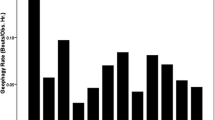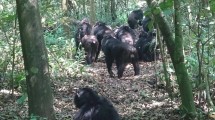Abstract
Geophagy is the intentional consumption of soil and has been observed in various animal taxa including human and nonhuman primates. Among the numerous adaptive hypotheses proposed to explain this behavior, two of them stand out: soil either protects the gastrointestinal tract from secondary plant compounds, parasites and pathogens, and/or supplements micronutrients in the diet. Few studies have characterized the physical and chemical characteristics of soils consumed by nonhuman primates. Here, we describe the composition of soils consumed by yellow-tailed woolly monkeys (Lagothrix flavicauda) in comparison with soils taken from surrounding areas. We also studied the physical aspects of geophagy sites in terms of accessibility, dimensions and vegetation density. This study took place at the La Esperanza field site, in northern Peru, between 2016 and 2018. We conducted focal follows, placed camera traps at geophagy sites and sampled soils. In total, we recorded 77 geophagy events. Our results highlight some aspects of soil and site selection in these arboreal primates, who face an increased predation risk when descending to the ground. Animals preferred smaller sites with denser surrounding vegetation. Composition of consumed soils was similar between geophagy sites. Soils were poor in micronutrients, but contained around 20% clay. High clay content, coupled with the fact that geophagy was performed significantly more in the dry season, when leaf consumption is highest, lends support to geophagy as a mechanism for protection of the gastrointestinal tract in L. flavicauda.







Similar content being viewed by others
References
Abrahams PW, Parsons JA (1996) Geophagy in the tropics: a literature review. Geogr J 162(1):63–72
Aufreiter S, Hancock RGV, Mahaney WC, Stambolic-Robb A, Sanmugadas K (1997) Geochemistry and mineralogy of soils eaten by humans. Int J Food Sci Nutr 48(5):293–305. https://doi.org/10.3109/09637489709028575
Blake JG, Guerra J, Mosquera D, Torres R, Loiselle BA, Romo D (2010) Use of mineral licks by white-bellied spider monkeys (Ateles belzebuth) and red howler monkeys (Alouatta seniculus) in Eastern Ecuador. Int J Primatol 31(3):471–483. https://doi.org/10.1007/s10764-010-9407-5
Chapman HD, Pratt PF, Contín A (1973) Métodos de análisis para suelos, plantas y aguas. No. 04; S587, C4y. México: Trillas
de Benedictis T (1973) The behavior of young primates during adult copulation: observations of a Macaca irus colony. Am Anthropol 75(5):1469–1484. https://doi.org/10.1525/aa.1973.75.5.02a00170
De Souza LL, Ferrari SF, Da Costa ML, Kern DC (2002) Geophagy as a correlate of folivory in red-handed howler monkeys (Alouatta belzebul) from eastern Brazilian Amazonia. J Chem Ecol 28(8):1613–1621. https://doi.org/10.1023/a:1019928529879
Ferrari SF (2009) Predation risk and antipredator strategies. In: South American Primates (pp 251–277). Springer, New York
Ferrari SF, Veiga LM, Urbani B (2008) Geophagy in New World monkeys (Platyrrhini): ecological and geographic patterns. Folia Primatol 79(5):402–415. https://doi.org/10.1159/000141901
Glander KE (1982) The impact of plant secondary compounds on primate feeding behavior. Am J Phys Anthropol 25(3):1–18
Gomes C (2018) Healing and edible clays: a review of basic concepts, benefits and risks. Environ Geochem Health 40(5):1739–1765. https://doi.org/10.1007/s10653-016-9903-4
Hladik CM, Gueguen L (1974) Géophagie et nutrition minérale chez les primates sauvages. CR Acad Sci Paris Ser D 279:1393–1396
Huffman MA (1997) Current evidence for self-medication in primates: a multidisciplinary perspective. Am J Phys Anthropol 104:171–200. https://doi.org/10.1002/(SICI)1096-8644(1997)25+%3c171::AID-AJPA7%3e3.0.CO;2-7
Hunter JM, De Kleine R (1984) Geophagy in central America. Geogr Rev 74(2):157–169
Izawa K (1993) Soil-eating by Alouatta and Ateles. Int J Primatol 14(2):229–242. https://doi.org/10.1007/BF02192633
Janson CH (1998) Testing the predation hypothesis for vertebrate sociality: prospects and pitfalls. Behaviour 1998:389–410
Johns T (1986) Detoxification function of geophagy and domestication of the potato. J Chem Ecol 12(3):635–646
Ketch LA, Malloch D, Mahaney WC, Huffman MA (2001) Comparative microbial analysis and clay mineralogy of soils eaten by chimpanzees (Pan troglodytes schweinfurthii) in Tanzania. Soil Biol Biochem 33(2):199–203. https://doi.org/10.1016/S0038-0717(00)00129-2
Klein N, Fröhlich F, Krief S (2008) Geophagy: soil consumption enhances the bioactivities of plants eaten by chimpanzees. Naturwissenschaften 95(4):325–331
Knezevich M (1998) Geophagy as a therapeutic mediator of endoparasitism in a free-ranging group of rhesus macaques (Macaca mulatta). Am J Primatol 44(1):71–82
Krishnamani R, Mahaney WC (2000) Geophagy among primates: adaptive significance and ecological consequences. Anim Behav 59(5):899–915. https://doi.org/10.1006/anbe.1999.1376
Link A, Galvis N, Fleming E, Di Fiore A (2011) Patterns of mineral lick visitation by spider monkeys and howler monkeys in Amazonia: are licks perceived as risky areas? Am J Primatol 73(4):386–396. https://doi.org/10.1002/ajp.20910
Mahaney WC, Krishnamani R (2003) Understanding geophagy in animals: standard procedures for sampling soils. J Chem Ecol 29(7):1503–1523. https://doi.org/10.1023/A:1024263627606
Matsuda I, Izawa K (2008) Predation of wild spider monkeys at La Macarena. Colombia Primates 49(1):65–68. https://doi.org/10.1007/s10329-007-0042-5
National Research Council (2003) Nutrient requirements of nonhuman primates. National Academies Press, Washington DC
Pebsworth PA, Bardi M, Huffman MA (2012) Geophagy in chacma baboons: patterns of soil consumption by age class, sex, and reproductive state. Am J Primatol 74(1):48–57. https://doi.org/10.1002/ajp.21008
Pebsworth PA, Huffman MA, Lambert JE, Young SL (2019) Geophagy among nonhuman primates: a systematic review of current knowledge and suggestions for future directions. Am J Phys Anthropol 168:164–194. https://doi.org/10.1002/ajpa.23724
Peres CA (1994) Composition, density, and fruiting phenology of arborescent palms in an Amazonian terra firme forest. Biotropica 1994:285–294
Shanee S (2014) Ranging behaviour, daily path lengths, diet and habitat use of yellow-tailed woolly monkeys (Lagothrix flavicauda) at La Esperanza, Peru. In: The Woolly Monkey (pp 167–185). Springer, New York
Shanee S, Shanee N (2011a) Population density estimates of the critically endangered yellow-tailed woolly monkeys (Oreonax flavicauda) at La Esperanza. Northeastern Peru Int J Primatol 32(4):878–888. https://doi.org/10.1007/s10764-011-9507-x
Shanee S, Shanee N (2011b) Activity budget and behavioural patterns of free-ranging yellow-tailed woolly monkeys Oreonax flavicauda (Mammalia: Primates), at La Esperanza, northeastern Peru. Contrib Zool 80(4):269–277
Shanee S, Shanee N (2018) Diversity of large mammals in the Marañón-Huallaga landscape, Peru: with notes on rare species. Zool Ecol 28(4):313–328
Stark NM, Jordan CF (1978) Nutrient retention by the root mat of an Amazonian rain forest. Ecology 59(3):434–437
Ta CAK, Pebsworth PA, Liu R, Hillier S, Gray N, Arnason JT, Young SL (2018) Soil eaten by chacma baboons adsorbs polar plant secondary metabolites representative of those found in their diet. Environ Geochem Health 40(2):803–813. https://doi.org/10.1007/s10653-017-0025-4
Underwood EJ, Suttle NF (1999) The mineral nutrition of livestock, 3rd edn. CAB International, Wallingford
Vermeer DE, Ferrell RE (1985) Nigerian geophagical clay: a traditional antidiarrheal pharmaceutical. Science 227(4687):634–636
Wakibara JV, Huffman MA, Wink M, Reich S, Aufreiter S, Hancock RGV, Sodhi R, Mahaney WC, Russel S (2001) The adaptive significance of geophagy for Japanese macaques (Macaca fuscata) at Arashiyama. Japan Int J Primatol 22(3):495–520
Walkley A, Black IA (1934) An examination of the Degtjareff method for determining soil organic matter, and a proposed modification of the chromic acid titration method. Soil Sci 37(1):29–38
Young SL (2010) Pica in pregnancy: new ideas about an old condition. Annu Rev Nutr 30:403–422
Young SL, Wilson MJ, Miller D, Hillier S (2008) Toward a comprehensive approach to the collection and analysis of pica substances, with emphasis on geophagic materials. PLoS ONE 3(9):e3147
Young SL, Sherman PW, Pelto GH (2011) Why on earth?: evaluating hypotheses about the physiological functions of human geophagy. Q Rev Biol 86(2):97–120
Acknowledgements
We wish to thank Noga Shanee, Nestor Allgas and Neotropical Primate Conservation for supporting this study and helping us with the research design, as well as all the local research assistants. We also thank Robin Hilario Fernandez for botanical sampling and species identifications at the Herbarium of the Universidad Nacional Agraria La Molina, in Lima, and Nicolas Poulin and Sébastien Ballesta for their help in the data analyses and interpretation of soil sample composition.
Funding
This study was funded by the Fonds National de La Recherche Scientifique (FNRS), the Fonds Léopold III pour l’Exploration et la Conservation de la Nature, and Neotropical Primate Conservation. All work was conducted in accordance with the laws of Peru, under the permit number 173-2016-SERFOR/DGGSPFFS.
Author information
Authors and Affiliations
Corresponding author
Ethics declarations
Conflict of interest
The authors declare that they have no conflict of interest.
Additional information
Publisher's Note
Springer Nature remains neutral with regard to jurisdictional claims in published maps and institutional affiliations.
About this article
Cite this article
Fack, V., Shanee, S., Vercauteren Drubbel, R. et al. Geophagy in the yellow-tailed woolly monkey (Lagothrix flavicauda) at La Esperanza, Peru: site characterization and soil composition. Primates 61, 507–518 (2020). https://doi.org/10.1007/s10329-020-00802-9
Received:
Accepted:
Published:
Issue Date:
DOI: https://doi.org/10.1007/s10329-020-00802-9




